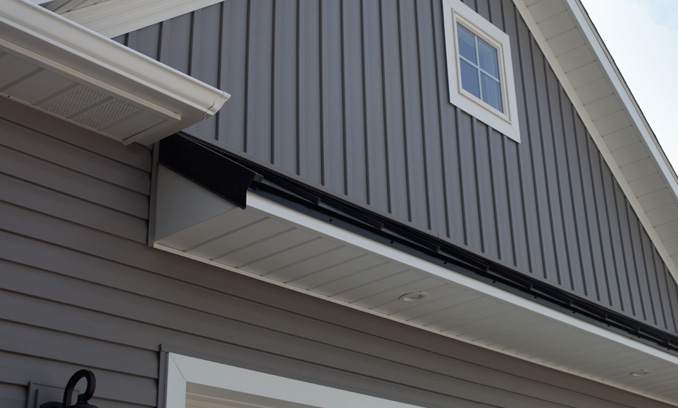When selecting the ideal siding material for your property, the debate between wood and vinyl has long been discussed among homeowners. Both options offer distinct advantages and considerations that can significantly impact your home’s aesthetics, durability, and maintenance requirements.
In this comprehensive comparison, we will explore the world of wood and vinyl siding, exploring their unique qualities, benefits, and factors to consider.
Wood Siding
Wood siding has a long history of adorning homes and is popular for those seeking classic beauty and natural warmth. Some key attributes of wood siding include:
- Aesthetics: Wood siding exudes a warm, inviting look that adds character and charm to any home. The natural grain patterns and variety of wood species offer various design possibilities, allowing homeowners to achieve a unique and customized appearance.
- Insulation: Wood is a natural insulator, providing better thermal performance than other siding materials. It helps to keep the interior of your home cool in summer and warm in winter, leading to potential energy savings and increased comfort.
- Environmental Sustainability: Wood is a renewable resource, making wood siding an eco-friendly choice. Wood siding has a lower carbon footprint when sourced from responsibly managed forests than synthetic alternatives.
- Repairability: In case of damage or wear over time, wood siding can be easily repaired. Minor issues such as scratches or dents can be addressed by sanding or applying fresh paint or stain, restoring the siding’s original beauty.
The Drawbacks of Wood Siding
- Maintenance: Wood siding requires regular maintenance to keep it in good condition. It needs to be periodically sealed, painted, or stained to protect it from moisture, rot, and insect infestations. Failure to maintain wood siding properly can lead to deterioration and costly repairs.
- Vulnerability to Weather: Wood siding is susceptible to weather-related damage. Exposure to moisture, extreme temperatures, and UV rays can cause warping, rotting, and fading. Proper installation, regular maintenance, and adequate protection from the elements are crucial to prolonging its lifespan.
- Cost: Wood siding tends to be more expensive upfront than other siding materials such as vinyl or fiber cement. Additionally, the ongoing maintenance expenses, including painting and sealing, should be considered when evaluating the overall wood siding cost.
- Fire Hazard: While wood siding can be treated with fire-retardant coatings, it is still more combustible than non-wood alternatives. Homeowners in fire-prone areas should carefully evaluate the fire resistance requirements and regulations before opting for wood siding.
Vinyl Siding
Vinyl siding has gained popularity over the years due to its durability, ease of maintenance, and cost-effectiveness.
Here are some of the advantages of vinyl siding:
- Durability: Vinyl siding is known for its exceptional durability. It resists harsh weather conditions such as rain, wind, and extreme temperatures. Unlike wood siding, it does not rot, warp, or crack over time.
- Low Maintenance: One of the primary advantages of vinyl siding is its low maintenance requirements. It does not require painting, staining, or sealing like wood siding. Regular cleaning with mild soap and water is typically sufficient to keep it looking fresh and clean.
- Versatility: Vinyl siding offers a wide range of colours, styles, and textures, allowing homeowners to achieve the desired look for their property. It can mimic the appearance of various materials, including wood, without the associated maintenance concerns.
- Cost-effective: Vinyl siding is generally more affordable than other siding materials such as wood or brick. Its lower installation and maintenance expenses make it an attractive option for budget-conscious homeowners.
- Energy Efficiency: Insulated vinyl siding options are available, which can improve the home’s energy efficiency by reducing heat transfer and lowering utility bills.
The drawback of Vinyl Siding
- Limited Customization: Unlike wood siding, which can be painted or stained in various colours, vinyl siding has limited customization options. Once installed, it is challenging to change the colour or appearance of the vinyl siding.
- Environmental Impact: Vinyl siding is made from PVC, a non-biodegradable material. Although efforts have been made to improve its sustainability, concerns about the environmental impact of vinyl production and disposal remain.
- Potential for Damage: While vinyl siding is durable, it is not impervious. It can be susceptible to impact from hail, fallen branches, or accidental collisions, resulting in dents or cracks that may require repair or replacement.
- Fading and Discoloration: Over time, vinyl siding may fade or discolour due to prolonged exposure to UV rays. While some high-quality vinyl siding products have fade-resistant properties, cheaper options may show signs of fading.
Choosing the Right Siding Material for Your Properties
When choosing between wood siding and vinyl siding for your home, several factors should be considered to make an informed decision. Here are the key aspects to keep in mind:
- Aesthetics: Consider your preference for the appearance of the siding material. Wood siding exudes natural beauty with its warm and inviting look and varied grain patterns, while vinyl siding offers a wide range of styles and colours but may have a synthetic appearance.
- Durability: Evaluate the durability of each material. Wood siding can last for decades with proper maintenance but requires regular upkeep to prevent rot and insect infestations. Vinyl siding is highly durable and resistant to weathering, with minimal maintenance needed.
- Maintenance: Assess the maintenance requirements of both materials. Wood siding demands periodic painting, staining, and sealing to protect it from moisture and maintain its appearance. Vinyl siding requires minimal maintenance, with occasional cleaning to keep it looking fresh.
- Cost: Compare the upfront costs and long-term expenses. Wood siding tends to have higher initial costs, including installation and maintenance, while vinyl siding is more affordable upfront and requires fewer ongoing expenses.
- Environmental Impact: Consider the environmental implications of your choice. Wood siding is a renewable resource when sourced responsibly, making it an eco-friendly option. Vinyl siding is recyclable but involves using fossil fuels and chemicals during production.
Conclusion
Choosing between wood and vinyl siding requires careful consideration of various factors, including aesthetics, maintenance, durability, and cost.
Phoenix Siding is your go-to service provider for all your siding needs. With a broad array of services, including the installation of hardi-plank, vinyl siding, cedar, corrugated metal, gutters, windows, soffit, and insulation, we have the necessary skills and experience to enhance the appeal and functionality of your property.
Call us at 250-758-3818 today to explore the best siding options for your home and enjoy a seamless and high-quality installation process.




